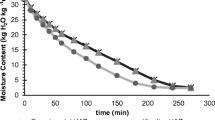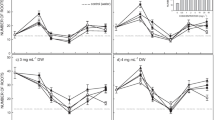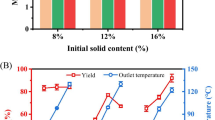Abstract
Chlorella vulgaris is known for its protein, growth factor, and nutritional constituents. Chlorella vulgaris was cultivated in a 1000-L outdoor open raceway pond with a maximum volumetric productivity of 130 mg L-1 day-1. The harvested biomass was dried through different methods, viz., sun drying (30 °C), oven drying (60 °C), lyophilization (−110 °C), drum drying (120 °C), and spray drying (100–150 °C). The effect of the drying method on proximate composition, pigments (chlorophyll, carotenoids), bioactive compounds (total phenolic content, flavonoid content), vitamin B12, antioxidant properties (ferric reducing antioxidant power, DPPH, and total antioxidant activity), and the color quality of C. vulgaris biomass was evaluated. Surface characterization by scanning electron microscopy (SEM) and functional group characterization through Fourier transform infrared spectroscopy were also performed. The biomass dried through lyophilization and sun drying retained maximum bioactive compounds and antioxidant activities. In contrast, drum drying resulted in a loss of nutrients, viz., protein (up to 44%), lipid (up to 41%), vitamin B12 (up to 40%), total phenolic content (> 50%), total flavonoid content (> 50%), and antioxidant activity (> 50%). Oven drying led to a loss of 30% in total flavonoid content and 17% in ferric reducing antioxidant power. SEM showed the destruction of cell wall integrity in the drum-dried sample and porous structure in the spray-dried sample. This study suggests that drying methods affect the nutrients and bioactive compounds of C. vulgaris biomass, and therefore a drying method should be selected carefully depending on the end use of the biomass.




Similar content being viewed by others
References
Agboola JO, Teuling E, Wierenga PA, Gruppen H, Schrama JW (2019) Cell wall disruption: an effective strategy to improve the nutritive quality of microalgae in African catfish (Clarias gariepinus). Aquac Nutr 25:783–797
Aguilar Urbano M, Pineda Priego M, Prieto P (2013) Spectrophotometric quantitation of antioxidant capacity through the formation of a phosphomolybdenum complex: specific application to the determination of vitamin E. Anal Biochem 269:337–341
Bampouli A, Kyriakopoulou K, Papaefstathiou G, Louli V, Aligiannis N, Magoulas K, Krokida M (2015) Evaluation of total antioxidant potential of Pistacia lentiscus var. chia leaves extracts using UHPLC–HRMS. J Food Eng 167:25–31
Bito T, Okumura E, Fujishima M, Watanabe F (2020) Potential of Chlorella as a dietary supplement to promote human health. Nutrients 12:2524
Cha KH, Koo SY, Lee DU (2008) Antiproliferative effects of carotenoids extracted from Chlorella ellipsoidea and Chlorella vulgaris on human colon cancer cells. J Agric Food Chem 56:10521–10526
Chan JC-C, Cheung PC-K, Ang PO (1997) Comparative studies on the effect of three drying methods on the nutritional composition of seaweed Sargassum hemiphyllum (Turn.) C. Ag. J Agric Food Chem 45:3056–3059
Chatzikonstantinou M, Kalliampakou A, Gatzogia M, Flemetakis E, Katharios P, Labrou NE (2017) Comparative analyses and evaluation of the cosmeceutical potential of selected Chlorella strains. J Appl Phycol 29:179–188
Dang TT, Vuong QV, Schreider MJ, Bowyer MC, Altena A IV, Scarlett CJ (2017) The effects of drying on physico-chemical properties and antioxidant capacity of the brown alga (Hormosira banksii (Turner) Decaisne). J Food Process Preserv 41:e13025
Daniel RM, Dines M, Petach HH (1996) The denaturation and degradation of stable enzymes at high temperatures. Biochem J 317:1–11
De Bhowmick G, Subramanian G, Mishra S, Sen R (2014) Raceway pond cultivation of a marine microalga of Indian origin for biomass and lipid production: a case study. Algal Res 6:201–209
Desai NM, Haware DJ, Basavaraj K, Murthy PS (2019) Microencapsulation of antioxidant phenolic compounds from green coffee. Prep Biochem Biotechnol 49:400–406
Djeridane A, Yousfi M, Nadjemi B, Boutassouna D, Stocker P, Vidal N (2006) Antioxidant activity of some Algerian medicinal plants extracts containing phenolic compounds. Food Chem 97:654–660
FSSAI (2016) Food safety and standards authority of India. Ministry of health and family welfare 1-4/ Nutraceutical/ FSSAI-2013:126 (Serial no.38).
García JL, de Vicente M, Galán B (2017) Microalgae, old sustainable food and fashion nutraceuticals. Microb Biotechnol 10:1017–1024
Gasmalla MAA, Yang R, Amadou I, Hua X (2014) Nutritional composition of Stevia rebaudiana Bertoni leaf: effect of drying method. Trop J Pharm Res 13:61–65
Germer SPM, Tonin IP, de Aguirre JM, Alvim ID, Ferrari C (2018) Influence of process variables on the drum drying of mango pulp. Dry Technol 36:1488–1500
Ghafoor K, Ahmed IAM, Doğu S, Uslu N, Fadimu GJ, Al Juhaimi F, Babiker EE, Özcan MM (2019) The effect of heating temperature on total phenolic content, antioxidant activity, and phenolic compounds of plum and mahaleb fruits. Int J Food Eng 15:20170302
Goiris K, Muylaert K, Voorspoels S, Noten B, De Paepe D, Baart GJE, De Cooman L (2014) Detection of flavonoids in microalgae from different evolutionary lineages. J Phycol 50:483–492
Grace CEE, Lakshmi PK, Meenakshi S, Vaidyanathan S, Srisudha S, Mary MB (2020) Biomolecular transitions and lipid accumulation in green microalgae monitored by FTIR and Raman analysis. Spectrochim Acta A 224:117382
Hemalatha A, Girija K, Parthiban C, Saranya C, Anantharaman P (2013) Antioxidant properties and total phenolic content of a marine diatom Navicula clavata and green microalgae Chlorella marina and Dunaliella salina. Adv Appl Sci Res 4:151–157
Ho YC, Show KY, Yan YG, Lee DJ (2019) Drying of Algae. In: Pang S, Bhattacharya S, Yan J (eds) Drying of biomass, biosolids, and coal: for efficient energy supply and environmental benefits. In: Pang S, Bhattacharya S, Yan J (eds) Drying of biomass, biosolids and coal for efficient energy supply and environmental benefits, CRC Press, Boca Raton, pp 97–117
Ihekoronye AI, Ngoddy PO(eds) (1985) Integrated food science and technology for the tropics. Macmillan, London, UK. p386
Irondi AE, Anokam KK, Ndidi US (2013) Effect of drying methods on the phytochemicals composition and antioxidant activities of Carica papaya seed. Int J Biosci 3:154–163
Janczyk P, Langhammer M, Renne U, Guiard V, Souffrant WB (2006) Effect of feed supplementation with Chlorella vulgaris powder on mice reproduction. Arch Zootech 9:14
Janczyk P, Franke H, Souffrant WB (2007) Nutritional value of Chlorella vulgaris: effects of ultrasonication and electroporation on digestibility in rats. Anim Feed Sci Technol 132:163–169
Jéssica L, Vega-Gálvez A, Torres MJ, Lemus-Mondaca R, Quispe-Fuentes I, Di Scala K (2013) Effect of dehydration temperature on physico-chemical properties and antioxidant capacity of goldenberry (Physalis peruviana L.). Chil J Agric Res 73:293–300
Khan MI, Harsha PS, Giridhar P, Ravishankar GA (2012) Pigment identification, nutritional composition, bioactivity, and in vitro cancer cell cytotoxicity of Rivina humilis L. berries, potential source of betalains. LWT Food Sci Technol 47:315–323
Kuck LS, Noreña CPZ (2016) Microencapsulation of grape (Vitis labrusca var. Bordo) skin phenolic extract using gum Arabic, polydextrose, and partially hydrolyzed guar gum as encapsulating agents. Food Chem 194:569–576
Kumar SS, Manoj P, Shetty NP, Giridhar P (2015) Effect of different drying methods on chlorophyll, ascorbic acid and antioxidant compounds retention of leaves of Hibiscus sabdariffa L. J Sci Food Agric 95:1812–1820
Kumudha A, Sarada R (2015) Effect of different extraction methods on vitamin B12 from blue green algae, Spirulina platensis. Pharm Anal Acta 6:2
Kumudha A, Selvakumar S, Dilshad P, Vaidyanathan G, Thakur MS, Sarada R (2015) Methylcobalamin–a form of vitamin B12 identified and characterised in Chlorella vulgaris. Food Chem 170:316–320
Lee AK, Lewis DM, Ashman PJ (2012) Disruption of microalgal cells for the extraction of lipids for biofuels: processes and specific energy requirements. Biomass Bioenergy 46:89–101
Lichtenthaler HK (1987) Chlorophylls and carotenoids: pigments of photosynthetic biomembranes. In: Packer L, Douce R (eds) Methods in enzymology. Elsevier, Cambridge, pp 350–382
Lubitz JA (1963) The protein quality, digestibility, and composition of algae, Chlorella 71105a. J Food Sci 28:229–232
Madhubalaji C, Rashmi V, Chauhan VS, Shylaja MD, Sarada R (2019a) Improvement of vitamin B12 status with Spirulina supplementation in Wistar rats validated through functional and circulatory markers. J Food Biochem 43:e13038
Madhubalaji CK, Shekh A, Sijil PV, Sandeep M, Chauhan VS, Sarada R, Ranga Rao A, Ravishankar GA (2019b) Open cultivation systems and closed photobioreactors for microalgal cultivation and biomass production. In: Ranga Rao A, Ravishankar GA (eds) Handbook of algal technologies and phytochemicals. CRC Press, Boca Raton, pp 178–202
Madhubalaji CK, Ajana P, Chauhan VS, Sarada R (2020a) Secondary metabolites of microalgae. In: Armugam M, Kathiresan S, Nagaraj S (eds) Applied Algal Biotechnology. Nova Science publishers, New York, pp 69–104
Madhubalaji CK, Chandra TS, Chauhan VS, Sarada R, Sandeep NM (2020b) Chlorella vulgaris cultivation in airlift photobioreactor with transparent draft tube: effect of hydrodynamics, light and carbon dioxide on biochemical profile particularly omega-6/omega-3 fatty acid ratio. J Food Sci Technol 57:866–876
Mogale M (2016) Identification and quantification of bacteria associated with cultivated Spirulina and impact of physiological factors. PhD Thesis, University of Cape Town.
Nielsen SS (2010) Phenol-sulfuric acid method for total carbohydrates. In: Nielsen SS (ed) Food analysis laboratory manual. Springer, Boston, pp 47–53
Özcan M, Arslan D, Ünver A (2005) Effect of drying methods on the mineral content of basil (Ocimum basilicum L.). J Food Eng 69:375–379
Pham HNT, Nguyen VT, Vuong QV, Bowyer MC, Scarlett CJ (2015) Effect of extraction solvents and drying methods on the physicochemical and antioxidant properties of Helicteres hirsuta Lour. leaves. Technologies 3:285–301
Plaza M, Santoyo S, Jaime L, Avalo B, Cifuentes A, Reglero G, Reina GGB, Señoráns FJ, Ibáñez E (2012) Comprehensive characterization of the functional activities of pressurized liquid and ultrasound-assisted extracts from Chlorella vulgaris. LWT Food Sci Technol 46:245–253
Quek SY, Chok NK, Swedlund P (2007) The physicochemical properties of spray-dried watermelon powders. Chem Eng Process 46:386–392
Ru ITK, Sung YY, Jusoh M, Wahid MEA, Nagappan T (2020) Chlorella vulgaris: a perspective on its potential for combining high biomass with high value bioproducts. Appl Phycol 1:2–11
Ryckebosch E, Muylaert K, Eeckhout M, Ruyssen T, Foubert I (2011) Influence of drying and storage on lipid and carotenoid stability of the microalga Phaeodactylum tricornutum. J Agric Food Chem 59:11063–11069
Sadasivam S, Manickam A (2008) Biochemical Methods, 8th edn. New Age International, New Delhi
Safi C, Zebib B, Merah O, Pierre-Yves P, Vaca-Garcia C (2014) Morphology, composition, production, processing and applications of Chlorella vulgaris: A review. Renew Sust Energ Rev 35:265–278
Skorupskaite V, Makareviciene V, Sendzikiene E, Gumbyte M (2019) Microalgae Chlorella sp. cell disruption efficiency utilising ultrasonication and ultrahomogenisation methods. J Appl Phycol 31:2349–2354
Stewart OJ, Raghavan GSV, Orsat V, Golden KD (2003) The effect of drying on unsaturated fatty acids and trypsin inhibitor activity in soybean. Process Biochem 39:483–489
Teuling E, Wierenga PA, Agboola JO, Gruppen H, Schrama JW (2019) Cell wall disruption increases bioavailability of Nannochloropsis gaditana nutrients for juvenile Nile tilapia (Oreochromis niloticus). Aquac 499:269–282
Theivandran G, Ibrahim SM, Murugan M (2015) Fourier transform infrared (FT-IR) spectroscopic analysis of Spirulina fusiformis. J Med Plants Stud 3:30–32
Tokuşoglu Ö, üUnal MK (2003) Biomass nutrient profiles of three microalgae: Spirulina platensis, Chlorella vulgaris, and Isochrisis galbana. J Food Sci 68:1144–1148
UN FAO, IFAD, UNICEF, WFP and WHO (2018) The state of food security and nutrition in the world 2018. Building climate resilience for food security and nutrition. FAO, Rome
Venkatesan S, Pugazhendy K, Sangeetha D, Vasantharaja C, Prabakaran S, Meenambal M (2012) Fourier transform infrared (FT-IR) spectroscopic analysis of Spirulina. Int J Pharm Biol Arch 3:969–972
Vidyashankar S, Deviprasad K, Chauhan VS, Ravishankar GA, Sarada R (2013) Selection and evaluation of CO2 tolerant indigenous microalga Scenedesmus dimorphus for unsaturated fatty acid rich lipid production under different culture conditions. Bioresour Technol 144:28–37
Vigani M, Parisi C, Rodríguez-Cerezo E, Barbosa MJ, Sijtsma L, Ploeg M, Enzing C (2015) Food and feed products from micro-algae: Market opportunities and challenges for the EU. Trends Food Sci Technol 42:81–92
Zhang X, Wang X, Wang M, Wang M, Cao J, Xiao J, Wang Q (2019) Effects of different pretreatments on flavonoids and antioxidant activity of Dryopteris erythrosora leave. PLoS One 14:e0200174
Acknowledgments
The authors thank the Director, CSIR-Central Food Technological Research Institute, Mysore, India, for providing facilities. CKMB acknowledges the Council of Scientific and Industrial Research, Government of India, for the award of SRF (31/005(0543)/2017-EMR-I). The authors also thank DBT, Govt. of India, New Delhi, India, for funding (Grant Number BT/PR6552/PBD/26/360/2012).
Author information
Authors and Affiliations
Corresponding author
Ethics declarations
Conflict of interest
The authors declare that they have no conflicts of interest.
Additional information
Publisher’s note
Springer Nature remains neutral with regard to jurisdictional claims in published maps and institutional affiliations.
Rights and permissions
About this article
Cite this article
Madhubalaji, C.K., Mudaliar, S.N., Chauhan, V.S. et al. Evaluation of drying methods on nutritional constituents and antioxidant activities of Chlorella vulgaris cultivated in an outdoor open raceway pond. J Appl Phycol 33, 1419–1434 (2021). https://doi.org/10.1007/s10811-020-02355-2
Received:
Revised:
Accepted:
Published:
Issue Date:
DOI: https://doi.org/10.1007/s10811-020-02355-2




